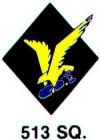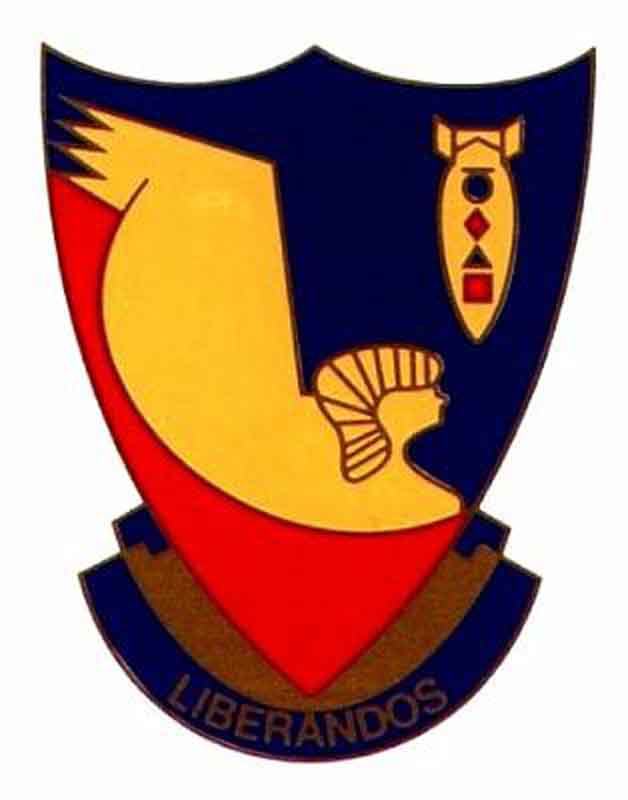Earl Kesler mission on July 2, 1944
THE VECSES AERODROME MISSION
By Earl Kesler
Dear Editor Grant,
Your article, "Connecting the Dots to the 'Granger' picture, in the recent "Intelligencer", was of considerable interest to me. It brought back memories, and added to my understanding of the events of July 2,1944. I long had wondered what had become of aircraft 29. Now it is evident that it was the John Jensen crew. A former classified report from 376th Bomb Group indicated that A/C 29 had engine trouble and turned back. The report states only that, "at 1114 hours pilot radioed base saying crew was bailing out at 44°15' N. l8°23'E. The report also said that A/C 43 was hit by flak on bomb run, caught fire, and exploded. I was the navigator on the Frank Rutherford crew, Squadron 513. We were on that July 2, 1944 mission to bomb Vecses aerodrome, Budapest, Hungary. We were flying A/C 43. The trip toward target had been uneventful with no opposition. Just after "bombs away" we received a direct hit in the bomb bay. The plane flew for a few moments, long enough for Bombardier Harry Chernik to get the nose wheel door open and for nose gunner Marion Oberling to get out of his turret. Chernik jumped. The plane then exploded trapping Oberling and me in the nose section. With a boost from me, he was able to get out. At first I was pinned in but then the spinning action released me. I fell free for as long as possible, then opened the chute and landed on the roof of a small one story concrete building. The payload that day consisted of 20-pound fragmentation bombs designed to scatter and damage parked aircraft. They were still exploding as I landed. Shrapnel from one that apparently was behind me passed through both legs, shattering the lower tibia. I managed to get off the building and through a blasted-open door to away the end of the explosions. Many years later, a Hungarian historian determined that the building was a garage. The historian, Geza Zainko is one of a group who active research events of World War TI and who were in the process of writing an account of the air war over Hungary from the viewpoints of the airmen involved. These include Hungarian, Russian, German, British, American and others. I was first in touch with Zainko and associates in the mid 1990's. They asked me to supply my recollections of events, which I did. Subsequently, they sent me a large amount of information. Apparently, their archives were extensive. For example there is a listing of all allied aircraft shot down over Hungary, which details type, manufacturer, crew, etc. Zainko located the site of the anti-aircraft battery, which apparently fired the shell which scored the direct hit on our aircraft. He sent copies of file photos of the tail section of a downed B-24. The serial number is plainly visible, 51151, unmistakably ours. I eventually learned of the fate of other crew members. Tail gunner Lawrence Davis, ball turret gunner Clifford Fenn, radioman James Van Bibber, and engineer James Huey lost their lives either immediately or shortly after the explosion. Top turret gunner Gene Doshier suffered severe wounds and burns on feet, legs and hands but survived. Copilot Roger Bullard had burns and a fractured pelvis from which he recovered. Pilot Rutherford, bombardier Chernik, and gunner Oberling were not seriously injured.
After the bombs stopped exploding I was picked up by two Hungarian soldiers. They assisted me to a truck on which I was transported to an aid station along with some wounded civilians. Later, I was taken by ambulance (along with Gene Doshier) across city to a hospital. I have since learned that it was called Military Hospital Eleven, located about six blocks west of the Danube and near the South Rai1way Station. It apparently was an auxiliary to another large military hospital located elsewhere in the city. We were fortunate to be in the smal1er No. I I. As allied airmen were captured the most seriously hurt were brought to the hospital and treated until able to move out and into channels leading to prisoner of war camps. Because we were considered serious, Doshier and I remained there until evacuation in mid-November. Usually there were 35 to 40 allied airmen in the hospital ward.
We were treated well. The medical staff was compassionate and kind. The resources were limited, however, they did a good job considering the circumstances. Many of the nurses appeared to be middle-aged volunteers. Some befriended us in small but appreciated ways. Dr. Lajos Placsko and Dr. Imiry Sukovathy apparently were assigned as our main doctors. I believe that Dr. Sukovathy saved my life. After about two weeks my right leg wound worsened with rampant infection. Dr. responded to an emergency call from the nurses on a Saturday evening. He was in formal evening clothes, having left a dinner party. He worked on me for more than an hour, opening the cast, inserting drainage tubes, applying sulfa (they had no penicillin). Thereafter my condition improved slowly; eventually I was able to walk.
Russian troops were approaching Budapest. Therefore we were evacuated on November 17th, 1944. We were moved by train to Gyor in western Hungary. There we were turned over to a small detachment of German soldiers whose function was to move prisoners into the regular German prison camp network. I ended up in Stalag Luft I on December 27. From there we were liberated by Russian troops the following May.
******
In September 2000, I went to Budapest accompanied by my wife, Wilna, our Son and his family. We were greeted with open arms and treated as VIP's. Zainko published a booklet outlining my story in detail. There was a welcoming ceremony followed by a reception and tour of the "old" airport, the one which had been rebuilt after the war and was still in use. There was coverage by press, radio and TV. The airport manager himself conducted the tour. The "old" facility adjoins the newer Ferihegy International airport. They seem appreciative of my stated purpose in returning to express my thanks for the humane care and treatment afforded me many years ago. An additional highlight - we met and had lunch with the widow of Dr. Sukovathy, a daughter of Dr. Placsko and a niece of one of the nurses.


The website 376bg.org is NOT our site nor is it our endowment fund.
At the 2017 reunion, the board approved the donation of our archives to the Briscoe Center for American History, located on the University of Texas - Austin campus.
Also, the board approved a $5,000 donation to add to Ed Clendenin's $20,000 donation in the memory of his father. Together, these funds begin an endowment for the preservation of the 376 archives.
Donate directly to the 376 Endowment
To read about other endowment donation options, click here.
Reunion
NOTE change in the schedule !!
DATES: Sep 25-28, 2025
CITY:Rapid City, SD
HOTEL: Best Western Ramkota Conference Hotel; 2111 North LaCrosse St., Rapid City, SD 57702; 605-343-8500
Click here to read about the reunion details.



















